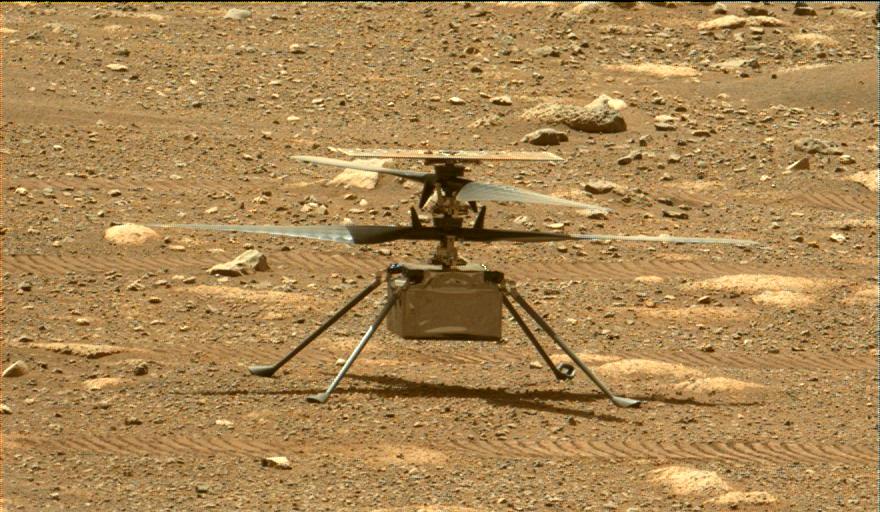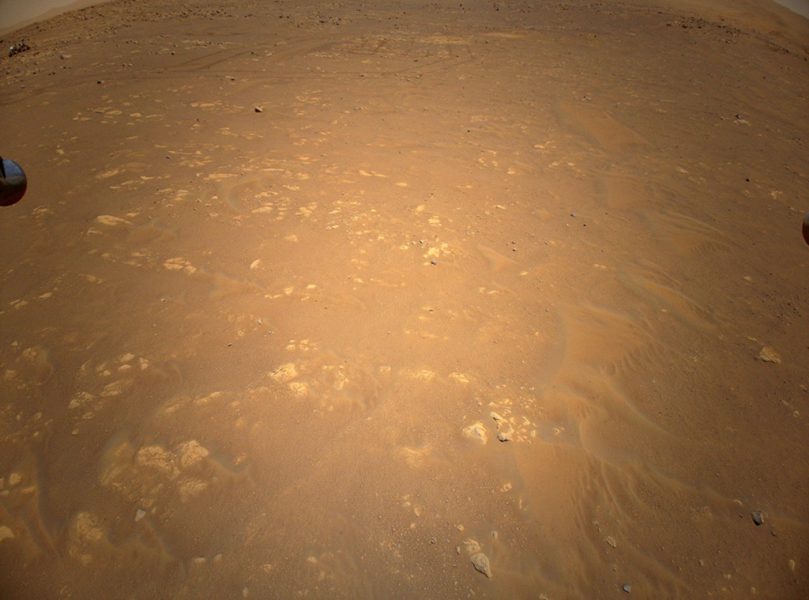After a successful first month of flights on Mars, Ingenuity will continue to fly through Martian skies on an extended mission designed to test operations.
Updates:
The fifth flight, too, was successful: a one-way trip 129 meters (423 feet) to the south of the Wright Brothers Field. Read details in NASA's press release.
Updates:
Watch video — and audio! — of the successful fourth flight here:

NASA / JPL-Caltech / ASU
On April 19, 2021, the Ingenuity Mars Helicopter made history, with the first powered flight on another planet. Since then, the helicopter has flown farther, higher, and faster on successive flights. Now, NASA announced on Friday that it will end the one-month demonstration phase for the intrepid helicopter, and extend its operational capabilities for at least another month.
“The Ingenuity technology demonstration has been a resounding success,” says associate administrator Thomas Zurbuchen (NASA Science Mission Directorate) in a recent press release. “Since Ingenuity remains in excellent health, we plan to use it to benefit future aerial platforms while prioritizing and moving forward with the Perseverance rover team’s near-term science goals.”
Ingenuity was set to complete its fourth flight last Thursday, April 29th, before a software glitch caused the helicopter to fail to transition into flight mode. Mars is currently about 17 light-minutes distant, meaning the helicopter is on its own to carry out flights. NASA engineers fixed the glitch and re-uploaded the pre-flight program to the helicopter via the worldwide Deep Space Network. The flight was successful the very next day, on April 30th.
The helicopter flew for 117 seconds, reached an altitude of 4.9 meters (16 feet), and ranged out over a round-trip of 266 meters to the south, snapping images along the way, before it returned to the Wright Brothers Field landing site. Ingenuity broke its own flight speed record on this flight, moving at a maximum of 3.5 meters per second (7.8 mph).
Just another day on Mars, shooting video of a flying helicopter. Quick preview of #MarsHelicopter’s Flight 4 takeoff below; more pics and video yet to come.
Typical photographer: lots of gear to juggle and mountains of files to upload! Newest pics at: https://t.co/L6lhCNdqWq pic.twitter.com/jpJHeDuQcA
— NASA's Perseverance Mars Rover (@NASAPersevere) April 30, 2021
The rover is on the move again as well. On Sol 66 (April 26th), Perseverance drove 10 meters south of the Jakob van Zyl overlook, resuming its search for new science targets.

NASA / JPL-Caltech
“We have appreciated the support provided by the Perseverance rover team during our technology and demonstration phase,” says MiMi Aung (NASA's Jet Propulsion Laboratory) in a recent press release. “Now we have a chance to pay it forward, demonstrating for future robotic and even crewed missions the benefits of having a partner nearby that can provide a different perspective.”
The half-meter-high helicopter is light, at 4 pounds (1.8 kilograms), and solar powered. Two pairs of counter-rotating blades spin at 2,500 rpm to create lift against the tenuous Martian atmosphere, which has only 1% the density of Earth’s air at sea level. Ingenuity does not carry any science payloads, but it does have a laser altimeter, a 13-megapixel color camera, and a 0.5-megapixel black-and-white camera onboard. Ingenuity relies on Perseverance to communicate with Earth but can range up to about a kilometer from the rover.

NASA / JPL / Caltech
The one-month extension transitions Ingenuity from a technology demonstration, simply showing that flight is possible on Mars, to an operations mission that demonstrates methods and techniques for future aerial missions.
Watch for flight five — the final planned checkout flight — to occur sometime this week, no earlier than May 7th. In another first, Ingenuity will leave the Wright Brothers Field site for good, flying downrange to a new landing site. This is riskier than previous flights, as the helicopter must land at the new site on its own. Along the way, the helicopter will snap images from its aerial perspective of the new terrain ahead of Perseverance rover, another plus for the mission.

NASA / JPL-Caltech
Expect to see the flight cadence to slow down during this new operational phase, from a flight every 2 to 3 days, to one every 2 to 3 weeks. In June, NASA will assess Ingenuity’s performance. However, October’s solar conjunction, when the Sun comes between Earth and Mars and disrupts radio communication, will probably spell the end for Ingenuity.
Perseverance has already been an amazing mission since its sky hook landing in Jezero Crater at the Octavia E. Butler landing site on February 18, 2021. It will be exciting to see Ingenuity fly on in coming weeks as a robotic scout for the Perseverance rover.
 2
2









Comments
Yaron Sheffer
May 6, 2021 at 3:17 pm
So, Ingenuity saw its shadow. This means 6 more weeks of winter for Mars, right?
You must be logged in to post a comment.
New Jersey Eclipse Fan
May 7, 2021 at 7:12 pm
That thought also crossed my mind. GMTA!
You must be logged in to post a comment.
You must be logged in to post a comment.